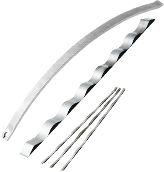- keyword
- load
- pianowire
- compressionsprings
- springfatigue
- permanentdeformation
- fatigueresistancematerial
Question TETSU 2006/2/17(Fri) 21:10
I have a question for you.
I think that the spring fatigue = permanent deformation, but is it okay to think that the load at the time of fatigue increases as the material hardens?
Also, in the case of a fatigue-resistant material such as piano wire, do you think that it does not sag = softens due to repetition = the load decreases?
I may have confused you with my question, but I look forward to receiving your reply.
Answer Tokai Spring 2006/2/20(Mon) 16:04
Thank you for writing to us, TETSU!
Fatigue occurs if a force that exceeds the elastic limit of the spring is applied to the spring even once. (Permanent deformation)
This is the case when setting is used. In general, this elastic limit has a certain relationship with the tensile strength of the material, and how much it should be bent to sag … can be calculated to some extent depending on the material and the spring’s dimensions.
When this fatigue occurs, the reaction force of the spring is reduced by that amount, so if a large amount of fatigue occurs, the spring will no longer function as a spring, and eventually, it will become a spring that is not broken but is useless.
* Setting: In the final process, a spring that has been coiled and heat-treated is loaded with stress higher than the elastic limit of the material in the direction of use. A kind of plastic working.
We are happy to answer any inquiries regarding technology, specifications, materials, etc. Please feel free to ask.

















